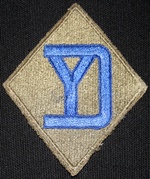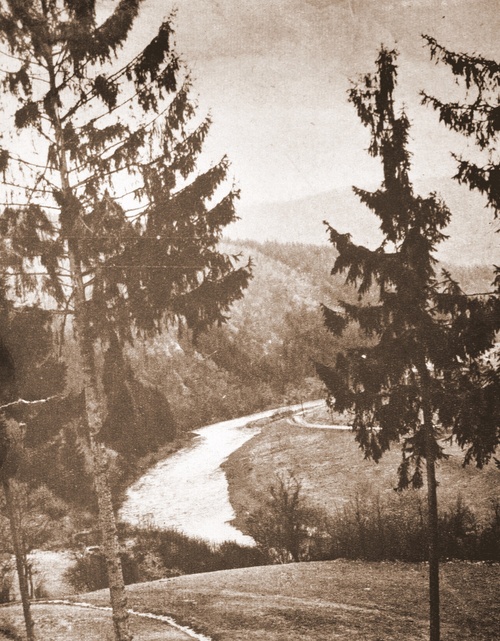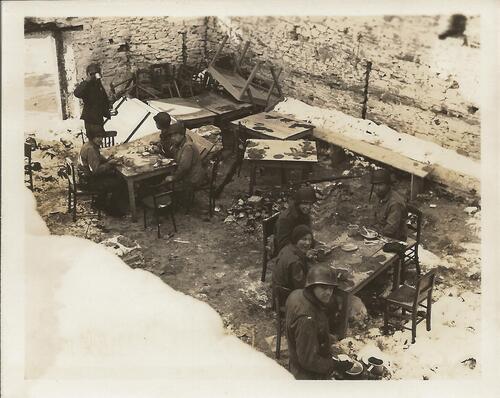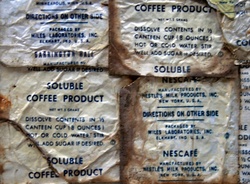-
Rhineland Campaign - 193rd GIR
 Friday January 26, 1945. The Regiment moved by trucks in the vicinity of Wiltz, Great Duchy of Luxembourg to relieve the 26th Infantry Division (see shoulder sleeve insignia on the left (TFH collection)). The First Battalion established in the town while the Second Battalion established in Erpeldange (north of Wiltz) and headquarter at Nieder-Wiltz. The entire regiment started arriving at 22h00 approximately. The men cleaned materiel, guns and equipments during the night. While it was at Wiltz, the Battalion received some replacement.
Friday January 26, 1945. The Regiment moved by trucks in the vicinity of Wiltz, Great Duchy of Luxembourg to relieve the 26th Infantry Division (see shoulder sleeve insignia on the left (TFH collection)). The First Battalion established in the town while the Second Battalion established in Erpeldange (north of Wiltz) and headquarter at Nieder-Wiltz. The entire regiment started arriving at 22h00 approximately. The men cleaned materiel, guns and equipments during the night. While it was at Wiltz, the Battalion received some replacement.There was no human loss during that day.
 Saturday January 27, 1945. At 09h30 the regimental commander received order to relieve the 317th Infantry Regiment, 80th Infantry Division (see shoulder sleeve insignia on the right (TFH collection)) on its positions. At that time Company HQII still had only four mortars and two machine guns.
Saturday January 27, 1945. At 09h30 the regimental commander received order to relieve the 317th Infantry Regiment, 80th Infantry Division (see shoulder sleeve insignia on the right (TFH collection)) on its positions. At that time Company HQII still had only four mortars and two machine guns.In the afternoon the Regiment moved in the vicinity of Bockholz-les-Hosingen and opened an advance command post at 18h00 approximately. Headquarters and Headquarter Company arrived from 24h00 on. The 317th Infantry Regiment was completely relieved during the night.
At least two patrols in Company E, one of them consisting of twenty-five men, were organized toward east and Hosingen. The GI’s didn’t find Germans soldiers in the little town but it was completely trapped. They made contact with the next units and captured few prisoners. There were also a lot of mines and snow on the area and Company A from the 139th Engineer Battalion received order to clean roads in the area of the 193rd Regiment.
Sunday January 28, 1945. The Second Battalion supported by First Platoon of Company A, Second Platoon of Company D (?), 3rd Chemical Battalion, Battery B of the 735th Tank Battalion, First Platoon of the 602nd Tank Destroyer Battalion (M18 Hellcat tanks) and 155th Anti-Aircraft Battalion besieged Hosingen and hills north-east and south-east of the town.
PJ Rice remembers:
“In the morning 4.2 mortars drove up and positioned to our rear to support our attack. They were surprise to see us carrying the 81’s…
It was open ground up a slope with a curving road leading to Hosingen. There were snipers in the houses at the edge of town but the mortars were able to subdue them and we moved into the town that afternoon. Again there were bodies head to foot along the road…
Hosingen had been difficult for the 317th. The Gis in the ditches had been pinned down by machine gun fire. The town had been held by K Company 110 Infantry and Engineer Company of the 28th (Bloody Bucket) when the Bulge started.
In a narrow road, there was a mess line set up. Garbage cans full of rations on burners all shot up. They must have been hit just before breakfast.
Off the main road behind the church, 5 or 6 roads meet and in the center of this junction stands a 16th century chapel (still standing today bearing shrapnel and bullet scars of WWII).
Before moving the guns forward, Sergeant Smith and Joe Dean went forward to scout gun positions. Joe returned with a German prisoner. As Joe explained, to save time Joe and the Sergeant separated. During a shelling, Dean hit the dirt. As he moved to get up he found himself looking at the wrong end of an enemy rifle with a German Sergeant on the other end. The Sergeant threw down the gun and held up his hands.
After the guns were in place, we were told we would fire our first rounds into Germany. It required maximum range and all the charges. Hicks informed us that we were firing on the Siegfried Line.”
The First Battalion stayed in regimental reserve and took the previous position of the Second Battalion.
In the afternoon a meeting was organized with regimental and battalion commanders to prepare action against the hilltops west of Our river the next day. The two battalions would be engaged.
Monday January 29, 1945. At 14h00, Company A and E, without specific winter wears, started the assault in deep snow. Company HQII stayed in the same position.
First Battalion was stopped because of intensive artillery and machine gun fires. At 16h30 men were obliged to leave north part of the aim because eighteen men on twenty engaged were wounded (I haven’t found information about the unit concerned).
At 17h00 the Second Battalion reached its aim in spite of eleven wounded (it is important to note that there are two different stories in official records with one that mentioned that the Second Battalion couldn’t reach the objective). Despite intervention of the artillery on enemy observation posts, the GI’s were rapidly obliged to withdraw because of the violence of German artillery fire coming from the Siegfried line.
At the end of day, the two battalions had joined their initial positions. They had not gain any ground but there were a lot of casualties in the two advance companies. They had captured twenty-one German prisoners who were members of the Headquarter Company, 988th Volksgrenadier Regiment of the 276th Infantry Division.
Night patrols were sent in German lines. They reported that Germans were still strongly entrenched on the west bank of the Our river.
Sergeant George T Mayer (Co HQII) shot himself as explained PJ Rice:
“Sergeant Mayer shot himself in the leg or foot just before he was to go to the OP. sergeant Mayer had his section upstairs. It wasn’t the best place to be in and when the German artillery let loose, John Marczyk said he heard the call medic, medic before the shot. A courts martial decided it wasn’t an accident. Bob Jackson heard that Sergeant Mayer got out in 10 years. Sergeant Frame testified against Mayer.”
Soldier First Class Calvin Fisher (33436524 – Co A) died after being wounded.
These two photos from "TALON with the 17th in Ardennes" show very well the Our river during the Second World War. The German border and the Siegfried line were behind this river (TFH collection).
Tuesday January 30, 1945. At 15h00 an observation post was installed on a hilltop near the 193rd area to survey German movements and guide artillery fire (US coordinates 840-596). A few hours later, the regiment was relieved from the front line. So its war operations on the Bulge and Rhineland campaigns came to the end.
This day, First Lieutenant John J Hammerstrom was wounded. Lying in the open, the enemy tried to use him as bait. Eventually Lieutenant Bailey of Company D rescued him that evening.
Wednesday January 31, 1945. In the afternoon the 513th Parachute Infantry Regiment relieved the regiment. Operation was finished at 17h50 and the regiment returned toward Wiltz where it arrived from 19h00 on.
Sergeant Kenwood D Beatty (16109842 – Co A) died that day after being wounded [1].
They didn’t know it but the men of the 193rd Glider Infantry Regiment had just joined the battle for the last time in the Bulge. Their soldiers had fought more than one month in terrible climatic conditions. Survivors remember very well that. In a mail of year 2000 Harold Osborn (Co E) wrote:
« It was very cold and a lot of men froze their feet…the snow was very deep, I remember this so well! … At night we would sleep in holes the Germans had dug… for many days we had to eat nothing but K rations. I remember when spring came and the snow went off, there were dead horses and men laying everywhere ! ».
K-Ration Dining Hall ! It was not easy to eat in first line for there GI’s (TFH collection).
K-Ration and remains packages contain in K-Ration (found during digs some years ago around Bastogne. At this time, it was easy to find their relics in Ardennes woods ...) (TFH collection).
From Thursday 01 to Saturday February 10 the regiment stayed at Wiltz where it dressed their wounds. Irvin Shore (Co E) remembers very well after being at the front for most of January they were finally given a break. They slept in a barn somewhere in Belgium (it is perhaps in the Great Duchy of Luxembourg). At that time he thought that was the most wonderful place in the world.

This official US Army photo shows an aerial view of Wiltz during the winter 1944-45. The city was liberated only in the last days of the battle of the Bulge. When the 193rd Infantry Regiment’s men came in the first days of February they helped the civilians to clean the town.
That was the first time they were out of the cold and snow for more than three weeks.
This time was used to rest, clean, test armaments and maintain equipment. With the 184th Engineer Battalion the soldiers helped civilian people to clean the city. A lot of mines were neutralized and they shoveled away dead animals and other remains.
From February 02 to 04 the Second Battalion was send to a rest center located at Virton, Province of Luxembourg, Belgium. From February 04 to 06 the First Battalion was send toward Virton.
On February 09 the regiment prepared its travel toward Châlons-sur-Marne, France for the next day.
[1] I must mention here that another member of the 193rd Regiment was killed possibly during this campaign, Private Raymond F Laboch (ASN 32930507). I haven’t found any information about his death. There is another interrogation left. It is the death of Private First Class Gaetano J Minnitte (ASN 33699710) who died on April 08, 1945 after being wounded. He is reported in the Bulge casualties and I haven’t found out if he had been wounded during the Ardennes campaign or during Operation Varsity.







